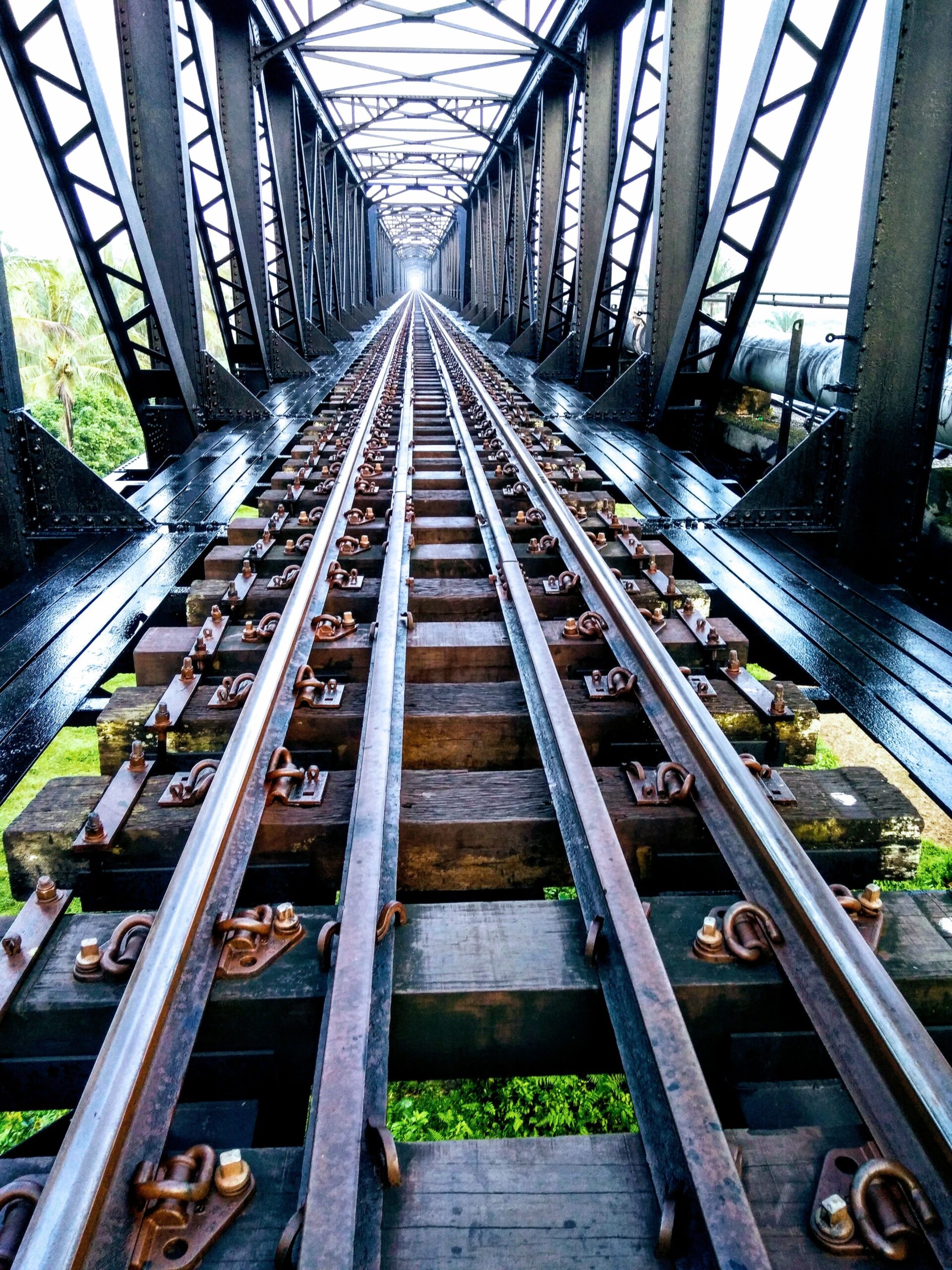A Comprehensive Approach to Designing Safe and Efficient Steel Railway Bridges
The “Analysis and Modeling in Designing Efficient Steel Railway Bridges” is a comprehensive resource that provides an introduction to the design principles and requirements for steel and composite railway bridges. Whether you’re a civil engineer, bridge designer, or involved in the railway industry, this guide is an invaluable tool. Thank you for your interest in the “Design Guide for Steel Railway Bridges.” This comprehensive resource has been meticulously crafted to cater to the needs of civil engineers, bridge designers, and professionals working in the railway industry. The guide serves as a valuable introduction to the design principles and requirements specifically related to steel and composite railway bridges.
Steel has been an integral material in the construction of railway bridges since the Victorian era. Its durability and strength have allowed these structures to stand the test of time, with many still in service today. Thanks to constant maintenance, refurbishment, and upgrades, these older steel bridges have adapted to modern needs. While most railway bridges are now built as replacements for older ones, there are also instances where entirely new structures are constructed on new alignments or routes. Notably, projects like the Channel Tunnel Rail Link demonstrate how steel continues to play a crucial role in creating innovative and efficient railway infrastructure for future generations.
Steel, with its remarkable durability and strength, has truly stood the test of time as an essential material in the construction of railway bridges. Since the Victorian era, steel has been integral in creating structures that have remained in service for decades. Through constant maintenance, refurbishment, and upgrades, these older steel bridges have successfully adapted to meet modern needs. While many railway bridges today are constructed as replacements for older ones, there are also instances where entirely new structures are built on new alignments or routes. These innovative projects showcase how steel continues to play a crucial role in creating efficient and forward-thinking railway infrastructure for future generations.
One notable example is the Channel Tunnel Rail Link project. This groundbreaking endeavor highlights how steel is used to create cutting-edge solutions that cater to evolving transportation demands. By utilizing steel’s exceptional properties, such as its high strength-to-weight ratio and versatility in design possibilities, engineers can construct bridges that efficiently connect different regions while ensuring safety and longevity. Moreover, steel’s sustainability credentials make it an ideal choice for railway bridge construction. With increasing focus on environmentally-friendly practices within the construction industry, using a material like steel allows for reduced carbon emissions compared to alternative options. Additionally, its recyclability ensures that at the end of a bridge’s lifespan or during refurbishment projects, materials can be repurposed rather than discarded. In conclusion, from Victorian-era railway bridges still serving their purpose today to innovative projects like the Channel Tunnel Rail Link project pushing boundaries with modern designs – there is no denying that steel continues to be indispensable when it comes to constructing reliable and efficient railway infrastructure. Its durability, strength, adaptability to modern needs along with its sustainable qualities make it an unrivaled choice for building structures that will benefit future generations of commuters and travelers alike.
Steel offers significant advantages when it comes to building replacement bridges. Its ability to achieve shallow construction depths is crucial in situations where the track level cannot be altered, but there is a need for sufficient clearance for highways or other services beneath the bridge. Moreover, steel construction lends itself well to prefabrication and preassembly, making the construction process more efficient. Additionally, due to its relatively lightweight nature, steel structures can be easily transported or lifted into position within short periods of time when railway closures are scheduled. This not only saves time but also minimizes disruption to traffic flow. Steel construction is indeed the ideal choice when it comes to building replacement bridges. Its shallow construction depths make it perfect for situations where the track level cannot be altered but clearance is needed for highways or other services beneath the bridge. This advantage alone sets steel apart from other construction materials. Furthermore, steel construction offers the added benefit of being highly conducive to prefabrication and preassembly. This means that much of the construction work can be done off-site, resulting in a more efficient and streamlined process. Not only does this save time, but it also ensures a higher level of quality control. Another advantage of steel structures is their lightweight nature. This makes transportation and positioning a breeze, especially during scheduled railway closures. With steel, there’s no need to worry about prolonged disruptions to traffic flow as installation can be completed within short periods of time. In summary, choosing steel for replacement bridge construction provides significant advantages such as shallow depth capabilities, efficient prefabrication options, quick installation times during railway closures, and minimal disruption to traffic flow. These benefits make steel an exceptional choice for any project requiring durability, efficiency, and convenience.
Its wealth of information will undoubtedly prove invaluable as you navigate the complexities of bridge design. With a focus on providing clear guidance, this guide aims to enhance your understanding of crucial aspects such as structural analysis, material selection, construction methods, and maintenance considerations. By incorporating best practices and industry standards, it equips you with the necessary knowledge to ensure safe and efficient design solutions. Moreover, this resource is continuously updated with the latest advancements in bridge engineering technology. As an authoritative source of information, it helps bridge designers stay abreast of emerging trends while adhering to established codes and specifications. Whether you are a seasoned professional looking for a reliable reference or an aspiring engineer seeking guidance in steel railway bridge design projects, this guide is an essential tool that will assist you every step of the way.
Investing in this valuable resource ensures that you have access to comprehensive guidelines backed by years of experience and expertise. It empowers you with knowledge that can significantly impact project success rates while delivering optimal outcomes within budgetary constraints. Make use of this indispensable companion on your journey towards designing robust steel railway bridges that meet safety regulations and exceed client expectations.
The guide begins with an overview of the specific requirements for railway bridges, taking into account the dynamic loads and interactions with railway infrastructure. It covers factors such as train speed, axle loads, and track alignment, providing a solid foundation for bridge design. Thank you for providing an overview of the specific requirements for railway bridges. It is essential to consider dynamic loads and interactions with railway infrastructure when designing such structures. By taking into account factors like train speed, axle loads, and track alignment, we can ensure a solid foundation for bridge design. Understanding the dynamic loads imposed on railway bridges is crucial as trains exert significant forces while in motion. These forces include vertical loads from the weight of the train and its cargo, as well as lateral and longitudinal forces resulting from acceleration, braking, and curving movements. By considering these factors during the design phase, engineers can ensure that the bridge can withstand these dynamic loadings without compromising safety or functionality. Furthermore, interactions between railway tracks and bridge structures must also be carefully analyzed.
The alignment of tracks plays a vital role in determining how loads are distributed across a bridge span. Deviations in track alignment might result in uneven loading on different parts of the structure. Therefore, it is important to assess track geometry alongside other design considerations to minimize any potential negative effects on bridge performance. Axle loads are another critical factor that must be taken into account when designing railway bridges. Trains with heavier axle loads will exert greater pressure on individual sections of a bridge compared to trains with lighter axle loads. Understanding these variations allows engineers to appropriately dimension structural elements such as beams or girders to ensure they can adequately support the anticipated loading conditions. In summary, this guide provides valuable insights into meeting specific requirements for railway bridges by considering key factors like dynamic loading due to train movement and interactions with railway infrastructure including track alignment and varying axle loads. By following these guidelines during the design process, engineers can create robust structures that safely accommodate train traffic while ensuring long-term durability.
Discover the various construction methods commonly used for bridges of short to medium spans. Our simplified illustrations will help you visualize the cross-sectional arrangements. When it comes to selecting railway bridges, safety and reliability are paramount. Not only that, but minimal disruption to passengers and traffic is also crucial. This is why steel railway bridges are an exceptional choice as they perfectly align with these requirements. Thank you for your interest in bridge construction methods and the importance of safety and reliability in railway bridges. Steel railway bridges indeed offer exceptional advantages that align perfectly with these requirements.
Steel bridges are widely preferred for their durability, strength, and ability to withstand heavy loads. They are known for their excellent fatigue resistance, which is crucial for railway applications where repetitive stress can occur over time. Additionally, steel bridges can be constructed efficiently with minimal disruption to passengers and traffic due to their modular nature.
One commonly used construction method for short to medium span steel railway bridges is the beam bridge design. This involves placing horizontal beams across multiple vertical supports called piers or abutments. Beam bridges are simple yet effective, providing a strong deck that can support heavy train loads while maintaining stability. Another popular construction method is the truss bridge design.
Truss bridges consist of interconnected triangular elements that distribute weight evenly throughout the structure. This design offers exceptional load-bearing capacity while minimizing material usage, making it both cost-effective and efficient. For longer spans or specialized requirements, arch or suspension bridge designs may be considered as well.
Arch bridges utilize curved structural elements to distribute forces along the curve of the arches, providing strength and stability even over large distances. Suspension bridges use cables suspended from tall towers to support the deck below, allowing for long spans without intermediate supports. To help you visualize these different construction methods, we have included simplified illustrations showcasing cross-sectional arrangements commonly used in steel railway bridge designs. In summary, steel railway bridges offer a compelling combination of safety, reliability, durability and minimal disruption during construction. Whether it’s a beam bridge design for shorter spans or more complex structures like truss or suspension bridges for longer spans and specialized requirements – steel proves to be an exceptional choice that meets all these needs effectively.
Additionally, the guide delves into the construction issues that are unique to steel railway bridges. It addresses critical considerations such as fabrication, transportation, erection, and maintenance. By understanding these factors, bridge designers can ensure that the construction process is efficient, cost-effective, and compliant with industry standards.
The “Analysis and Modeling in Designing Efficient Steel Railway Bridges” is a comprehensive and user-friendly resource that combines theoretical knowledge with practical guidance. It includes case studies, design examples, and illustrations to enhance understanding and showcase best practices.
When it comes to railway bridge design, it’s crucial to have access to reliable and up-to-date information. The “Design Guide for Steel Railway Bridges” provides just that, enabling engineers and designers to make informed decisions and create safe, durable, and efficient structures.
Whether you’re embarking on a new railway bridge project or seeking to enhance your knowledge in this field, this guide is an essential reference. Trust the expertise and insights provided by this guide to ensure the successful design and construction of steel railway bridges.


2 thoughts on “The Role of Analysis and Modeling in Designing Efficient Steel Railway Bridges”